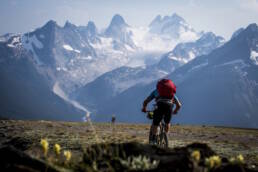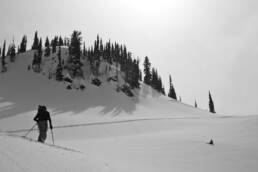Surging in popularity among cycling purists, bikepacking is gaining traction as a return to the adventurism and exploration of the pre-freeride era. One backcountry crew finds that their epic hike-a-bike through British Columbia’s Purcell Range is fraught with light treading and heavy scrutiny. By Andrew Findlay. Photographs by Ryan Creary.
If portents come in the form of a puff of cayenne pepper to the face, then I should have known I was about to be spanked. Ten minutes into the trail this morning, the lock on Reg Mullett’s bear spray dislodged, causing it to accidentally fire on Ryan Creary and me. Eight hours later, we’ve pedalled our bikes for one hour, tops, and carried or pushed them for seven. It’s late afternoon as I bench press my bike, laden with three days of food, a tent, a sleeping bag, and a minimum of extra clothing, up steep talus toward a desolate ridgeline, the sting of bear mace still lingering on my skin.
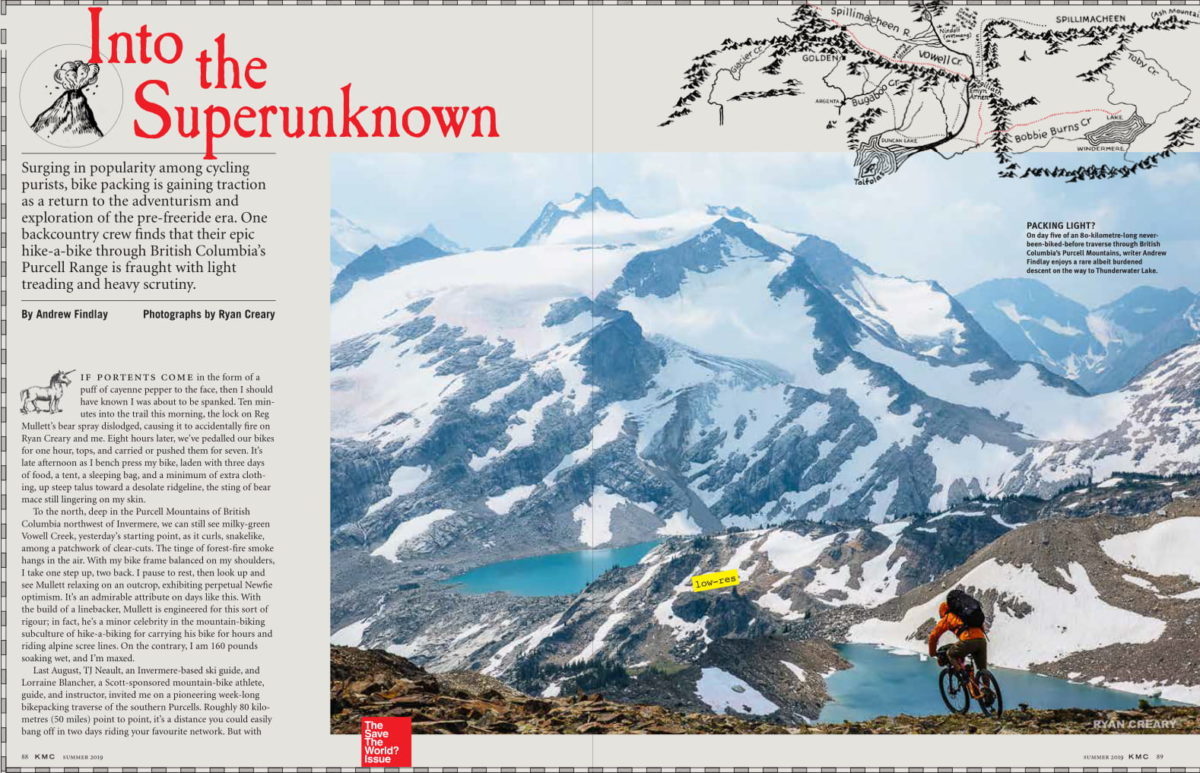
To the north, deep in the Purcell Mountains of British Columbia northwest of Invermere, we can still see milky-green Vowell Creek, yesterday’s starting point, as it curls, snakelike, among a patchwork of clear-cuts. The tinge of forest fire smoke hangs in the air. With my bike frame balanced on my shoulders, I take one step up, two back. I pause to rest, then look up and see Mullett relaxing on an outcrop, exhibiting perpetual Newfie optimism. It’s an admirable attribute on days like this. With the build of a linebacker, Mullett is engineered for this sort of rigour; in fact, he’s a minor celebrity in the mountain-biking subculture of hike-a-biking for carrying his bike for hours and riding alpine scree lines. On the contrary, I, being 160 pounds soaking wet, am maxed.
Last August, TJ Neault, an Invermere-based ski guide, and Lorraine Blancher, a Scott-sponsored mountain-bike athlete, guide, and instructor, invited me on a pioneering week-long bikepacking traverse of the southern Purcells. Roughly 80 kilometres (50 miles) point to point, it’s a distance you could easily bang off in two days riding your favourite network. But with thousands of metres in vertical gain and untold quantities of hiking, these would be hard-won kilometres. Thankfully, just enough time had elapsed since my first and only bikepacking experience for my memory to filter out the drudgery and leave behind rosy memories of flow trail and virgin singletrack. I was in, but also well aware that riding mountain bikes in the alpine is becoming controversial in British Columbia.

At the end of a logging spur high above Vowell Creek, 19 kilometres (12 miles) and 1,800 metres (5,906 feet) of vertical gain after leaving the trailhead, Neault, Blancher, Creary, Mullett, and I pedal along a faint path on uncharacteristically flat ground, relieved to reach our campsite in a meadow below Grizzly Peak, which is reflected perfectly in the mirror of a nearby alpine tarn. It would be postcard idyllic if not for the multitude of biting insects. They’re all here for the feast: black flies, no-see-ums, mosquitoes, and kamikaze horse flies, which I derive sadistic pleasure in crushing. “This is the one day that was a bit of an unknown,” Neault says, scanning for dissension in the ranks as we scramble to erect tents. The unknown. That’s the undeniable appeal of backcountry riding and perhaps the natural progression of the sport.
WHEN CALIFORNIA HIPPIES started exploring hiking trails on rigid frames, it signalled a paradigm shift, an awakening to what might be possible on two wheels. Naturally, those pioneers soon hit the hills with mattocks and rakes and began scratching out purpose-built bike trails. Bikes evolved. Front suspension forks with two inches of travel opened up new opportunities and new ways of thinking. The sport grew, and more riders traded car exhaust, slick tires, and asphalt for fresh air, knobbies, and dirt.
Fast forward a few decades and we have machine-built flow trails, bike parks sculpted by professional trailbuilders, and carbon-fibre dual suspension bikes that retail for the price of a down payment on a house.
My history of mountain biking is incomplete, shot through with as many holes as my bike socks, but it brings us to the here and now. Sort of. Contemporary mountain biking—motivated by the same desire for an unvarnished experience that propelled an explosion in backcountry skiing—has evolved to the point where a certain segment of riders is seeking to reconnect with the rawness that spawned the sport. It’s why people like Mullett, Neault, and Blancher are turning their attention to remote backcountry possibilities that, not that long ago, only fools would have considered attacking on bikes. “You ride the bike parks, flow trails, and eventually you want something else,” Neault says while we wait for our boil-in-the-bag beef stroganoff to hydrate.
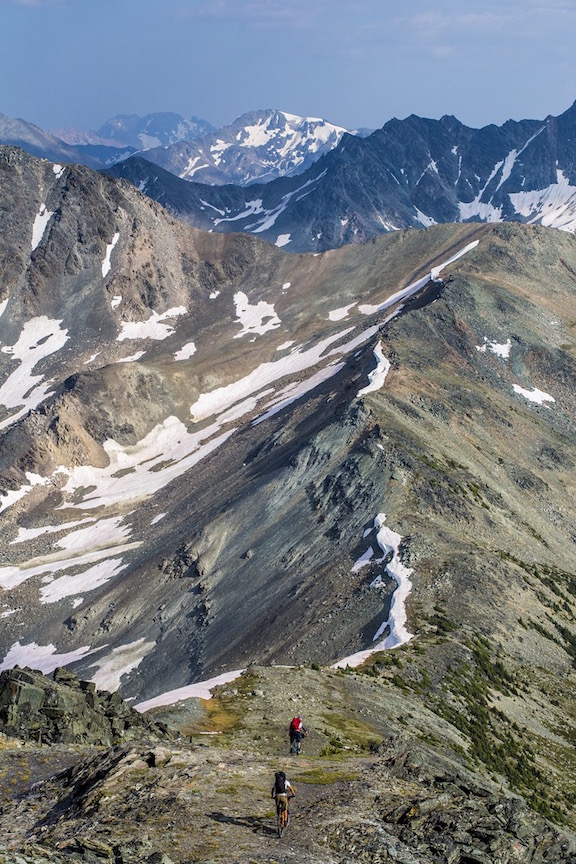
DAY TWO STARTS like day one, with a mix of “bike-aneering” and doubt raised by Class 4 scrambling on unstable, car-sized blocks of granite. Burdened with a loaded bike on the back, it’s easy to forget where we are, skirting a wild ridgeline with a 180-degree panorama of the Bugaboos’ dreamy amphitheatre of spires. Eventually there’s a payoff. Four hours after leaving camp, we gain Grizzly Ridge and some rideable terrain. “Isn’t this amazing? I just love this,” Blancher gushes, happy to be riding her bike instead of carrying it, seeking out knee-high drops and rock slabs.
I notice her shins, lacerated and bloody, like mine, from pedal strikes, as though a beaver had been gnawing on them for the past two days. It strikes me how tough Blancher is, in a bullheaded Soviet Olympic swimmer kind of way. At a saddle near the border of Bugaboo Provincial Park, we spot eight mountain goats grazing in a lush alpine pasture. The crack of tires on loose rock alerts them to our presence. The animals scramble to higher ground and watch circumspectly as we pass through their domain as discreetly as possible.
The self-serving mountain biker in me badly wants to ride the Cobalt Lake Trail, a hiking trail within park boundaries; it’s an increasingly common but controversial poach by a small cadre of adventurous mountain bikers. The trail would deliver us virtually to the doorstep of Bugaboos Lodge. But as a team, we decide better. In essence, it’s for the future of the sport, but it’s also because we will be guests at the lodge tonight, thanks to some pre-trip diplomacy by Blancher, who worked for Canadian Mountain Holidays (CMH), which operates the lodge, in another life. Instead we drop down Rocky Point, aiming for the valley of Bugaboo Creek, first on well-defined technical singletrack and then on an old squelchy mining-access road. Nature is reclaiming it, slowly transforming this relic of forgotten riches into a skinny, alder-fringed trail. Though it is far from flow, the sustained downhill is a relief. When we reach Bugaboo Creek, the valley is already in deep shade. Fatigued, we pedal for eight kilometres (five miles) up the forest-service road to the lodge.
Just two days into this venture and it feels like we’ve been to war. Decorum is forgotten as we enter the lodge, ascend the stairs, and assume stools at the bar. We are a dishevelled curiosity to the tidy guests. Despite this, longtime lodge manager Dave Cochrane gives us a warm welcome, instructing the chef to prepare a late meal, then ushering us to a table out of the earshot and sightlines of proper guests. As mountain bikers stepping into this hallowed lodge, it feels like we’re making a dubious pitch on the reality show Dragons’ Den. The CMH has been heli-hiking in and around Bugaboo Provincial Park for nearly four decades, and I know the incursion of mountain bikes does not sit well with many. Dave Butler, CMH’s vice president of sustainability, puts it this way, “I think the question should be whether or not mountain bikes should be permitted at all in the alpine, and if so, where and when?”
LIKE IT OR NOT, mountain biking is a late arrival to an already busy backcountry. More people are heading off trail, whether self-propelled or on mechanized toys, putting a strain on that limited resource called wilderness. Mountain biking is about as welcome in some venues as a bagpiper at a book club. It’s like that guy who shows up at the party uninvited: brash and fun-loving with a deep catalogue of off-colour jokes and a knack for staying until last call.
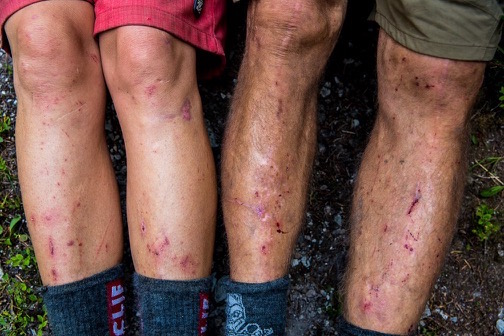
“We are seeing an explosion in popularity of public recreation of all kinds. Mountain biking is just another challenge for land managers,” says Tennessee Trent, trails manager for the British Columbia Ministry of Forests, Lands, Natural Resource Operations and Rural Development, the provincial government agency responsible for authorizing multi-use trails like Seven Summits in Rossland or Revelstoke’s Frisby Ridge. Though Trent believes the percentage of mountain bikers willing to undertake a trip like the southern Purcells traverse is small, he says there are, nonetheless, potential impacts on wildlife, sensitive alpine habitat, and First Nations traditional land use, not to mention conflicts with other well-established user groups. “I think there’s definitely work that needs to be done in terms of responsible use of mountain bikes in alpine areas,” says Trent, who, as an avid mountain biker, speaks to the topic with an honest and informed perspective.
Martin Littlejohn, executive director of the Western Mountain Bike Tourism Association (MBTA), takes nothing for granted. He believes that if the sport wants to grow and expand into remote wilderness areas, then sustainability and education must guide this new frontier. That’s why he doesn’t think a bike park-shredder mentality cuts it in alpine zones. “I’ve always viewed mountain biking as a privilege, and my message to people getting into backcountry riding is that we need to bring another level of respect for the environment,” he says.
These concerns prompted the MBTA to partner with Tyax Adventures, the South Chilcotin-based floatplane and mountain-bike guiding company, to produce the film Respect: A Call to Action for Sustainable Mountain Biking. It’s a preemptive effort to address the pressure of mountain biking in remote alpine areas. Littlejohn says the film has been well-received and hopes it sends the right message: backcountry mountain bikers need to step up their game. “We’re being watched,” says Littlejohn.
 That’s an understatement. A joint application by Retallack Lodge and the Yaqan nu?kiy First Nation for a 70,000-hectare Commercial Backcountry Recreation Tenure, which includes heli-biking, in the south Purcells has been given a rough reception by conservation groups like Kimberley, British Columbia-based Wildsight. So has Blackcomb Helicopters’ proposal for a 30-year tenure for heli-biking and trailbuilding in the Pemberton region. Saying the words “mountain bike” and “alpine” in the same sentence to someone like Pat Morrow, legendary photographer, author, mountaineer, and born-and-bred East Kootenay boy, is like poking a grizzly. “I’m intimately familiar with the terrain in the Retallack proposal. I ran a trapline on the headwaters of Redding Creek with my father in the late 1960s, fished and hunted in the adjoining watersheds, and hiked, skied, and climbed extensively all over the Purcells and adjoining Rockies,” Morrow says. “I can attest to the fact that wildlife was far more abundant back then in the proposed tenure and, for that matter, in the entire Kootenay-Columbia watershed than it is now.” Morrow believes British Columbia land managers should take their cue from Parks Canada, which so far does not permit alpine mountain biking. He calls it a “common-sense policy.”
That’s an understatement. A joint application by Retallack Lodge and the Yaqan nu?kiy First Nation for a 70,000-hectare Commercial Backcountry Recreation Tenure, which includes heli-biking, in the south Purcells has been given a rough reception by conservation groups like Kimberley, British Columbia-based Wildsight. So has Blackcomb Helicopters’ proposal for a 30-year tenure for heli-biking and trailbuilding in the Pemberton region. Saying the words “mountain bike” and “alpine” in the same sentence to someone like Pat Morrow, legendary photographer, author, mountaineer, and born-and-bred East Kootenay boy, is like poking a grizzly. “I’m intimately familiar with the terrain in the Retallack proposal. I ran a trapline on the headwaters of Redding Creek with my father in the late 1960s, fished and hunted in the adjoining watersheds, and hiked, skied, and climbed extensively all over the Purcells and adjoining Rockies,” Morrow says. “I can attest to the fact that wildlife was far more abundant back then in the proposed tenure and, for that matter, in the entire Kootenay-Columbia watershed than it is now.” Morrow believes British Columbia land managers should take their cue from Parks Canada, which so far does not permit alpine mountain biking. He calls it a “common-sense policy.”
However, it’s arguable that mountain bikers are being held to a different standard. For example, horses are still permitted on certain trails in Jasper and Banff national parks due mostly to historical precedent, not through any careful consideration of the impact this hay-burning, big-pooping, heavy-hoofed animal has on trails. When we rode a sublime granite slab from Thunderwater Lake toward the braided channels of Foster Creek, we found dozens of beer cans discarded by snowmobilers, a user group that has colonized the Catamount Glacier region in winter. But where’s the outrage? Blancher and Neault were far from thoughtless shredders when it came to planning this trip. Our route had three food drops to minimize weight and followed a mix of existing trail, old mining roads, and forest-service roads, all with an eye to minimizing off-trail alpine freeriding. As a member of the Columbia Valley Cycling Society, Neault is working hard to raise the profile of mountain bikers with the Summit Trail Makers Society, the hiking-focused old guard that maintains trails to popular Purcell Range destinations like Welsh Lakes. Winning over the skeptics takes work.
After a Bugaboos Lodge feast, I rinse off blood, sweat, and grime beneath a hot CMH shower. That night we tent next to the airstrip. Neault and Creary mistake the disconcerting grunts of a rutting buck for a grizzly, then spend half the night scoping the treeline with headlamps. The rest of us sleep soundly.
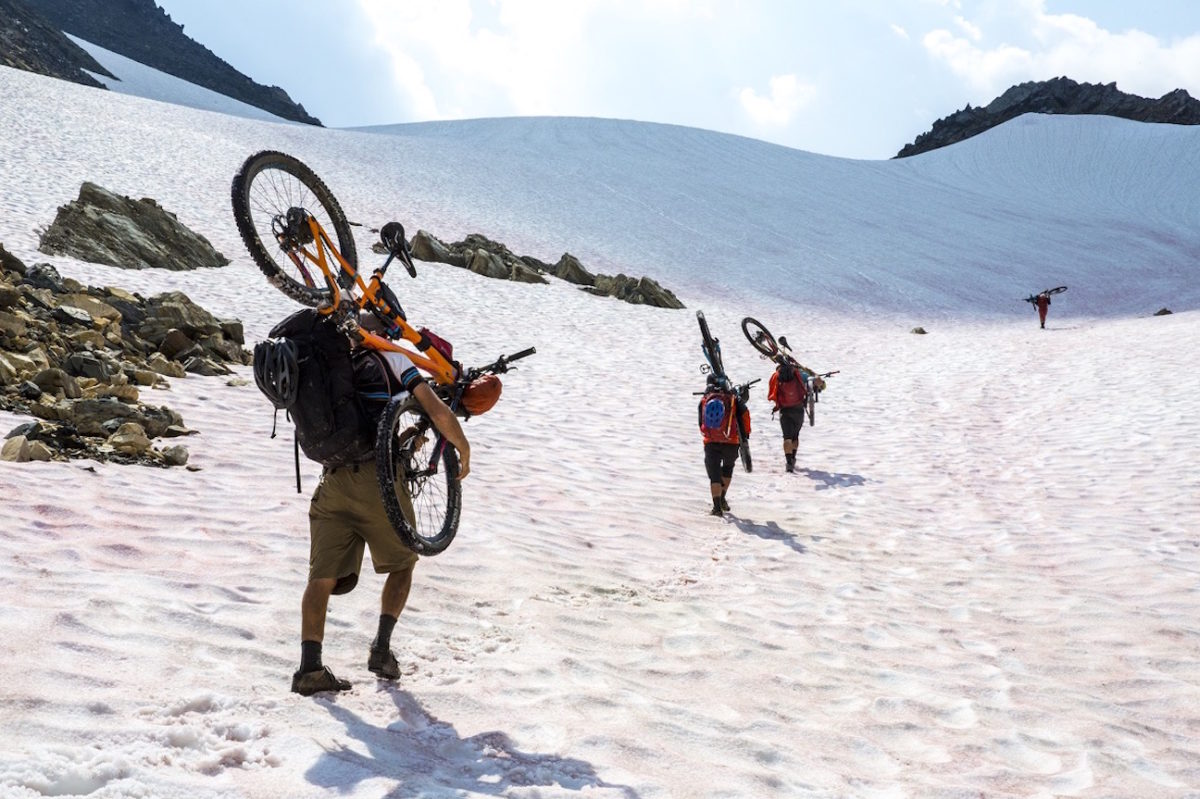
WE START LATE THE NEXT DAY after one of the CMH’s helicopter engineers does a stellar makeshift repair job on the sliced sidewall of my front tire. It’s a pleasant ride at first, a low-angled uphill on a logging spur, then onto singletrack that is surprisingly rideable. The afternoon air is still and hot; the babbling of Chalice Creek amplifies our thirst. The percussive thump of a Bell 212, shuttling CMH heli-hikers onto Chalice Ridge for a day of alpine strolling, briefly shatters the sounds of the wild around us.
A log bridge leads to the opposite bank, where the trail angles abruptly uphill. An hour of pushing brings us to open subalpine meadow, broken by copses of ancient larch, some of them with trunks as thick as fuel barrels. Then we ride the shore of a small lake and arrive at another scene of perfection: a wildflower meadow perched high above Septet Creek Valley. “Camping in places like this is a big reason why I love doing this,” Mullett says.
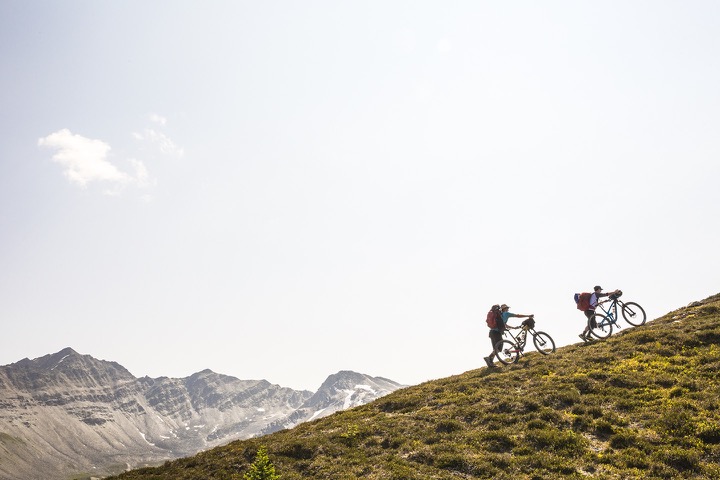 A short hike the next day and we’re riding a knife-edge ridge, following trail pounded by boots into a spicy stretch of technical alpine singletrack. It will only ever be ridden by folks willing to drive logging roads for a few hours and then heave their bikes up into the clouds—masochists like us. From the ridge, Mullett salivates over a juicy scree line. He hikes up to ride it. We watch as he pops a 1.5-metre (five-foot) rock drop onto 45-degree talus, hurtling downhill in what looks to me like a semi-controlled crash. He pulls it off impressively, leaving behind a thread that will be erased by the next rainfall or winter’s first snow.
A short hike the next day and we’re riding a knife-edge ridge, following trail pounded by boots into a spicy stretch of technical alpine singletrack. It will only ever be ridden by folks willing to drive logging roads for a few hours and then heave their bikes up into the clouds—masochists like us. From the ridge, Mullett salivates over a juicy scree line. He hikes up to ride it. We watch as he pops a 1.5-metre (five-foot) rock drop onto 45-degree talus, hurtling downhill in what looks to me like a semi-controlled crash. He pulls it off impressively, leaving behind a thread that will be erased by the next rainfall or winter’s first snow.
I select the easiest freeride line, a mix of slabs, glacial till baked hard by the sun, and mellow scree, aiming toward electric-green meadows near Septet Pass. Lower down, our tires ooze through soft streamside soils and moss, leaving incongruous scars. I feel guilty, momentarily. We search for a scant trail, the route that will take us down into the valley of Frances Creek. We find it, marked at first with pink ribbon, then the occasional cairn.
The five of us fall into train formation, following fast swooping trail that rolls ever steeper into dense forest. Hairpin switchbacks stretch my skills dangerously, like a two-sizes-too-small pair of spandex over a bruised butt cheek. Three mornings ago I hated my bike. Today I love it. I would lube the chain with extra virgin olive oil if I had some. The sense that we are likely the first to descend this remote trail on bikes fills me with strange satisfaction, enough that I forget the character-building sufferfest that defines backcountry bikepacking. The feeling is fleeting. Less than an hour later, we’re burrowing through an overgrown logging road in a valley bottom, swatting black flies, and getting slapped in the face by alders.
Andrew Findlay is a Vancouver Island writer who will one day go on another bikepacking adventure.
Related Stories
Big Easter Pow at Sol Mountain
Ski touring in the first week of April is always a good move. Long days, reliably cold temps, convective flurries, and…
Divine Ascension
From the archives, we give a super cool story from KMC Issue #9. Author Rob Buchanan takes us on a fascinating journey…
Book of the mountains – Trailer
"The Book of Mountains 3D" - a new film about skiing from Action Brothers, now in 3D! The film stars Ivan Oleynik, Ivan…
Heading to SWS
It's been puking up here in the Kootenays lately. A little on the warm side, but up in the big mountains it's cold and…


